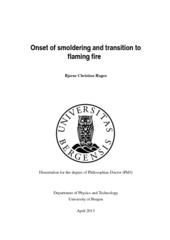| dc.contributor.author | Hagen, Bjarne Christian | eng |
| dc.date.accessioned | 2013-08-27T10:36:28Z | |
| dc.date.available | 2013-08-27T10:36:28Z | |
| dc.date.issued | 2013-06-28 | eng |
| dc.identifier.isbn | 978-82-308-2336-1 | en_US |
| dc.identifier.uri | https://hdl.handle.net/1956/6993 | |
| dc.description.abstract | Aim: The aim of this work has been to investigate the effects of density, heat flux and boundary conditions on smoldering. Two focus areas were chosen: the onset of smoldering and the transition from smoldering to flaming fire. Methods: Experiments using cotton batting were chosen to study smoldering combustion. Cotton was chosen since it can easily be compressed to a range of densities. Cotton, being mainly cellulose, is a material prone to smoldering. The cotton was compacted to a predetermined density and heated from below using a hotplate. Five densities were investigated: 20, 40, 60, 80 and 100 kg/m3, with six heat flux scenarios and two sets of boundary conditions. Findings: Results from paper I and II show that density affects the onset of smoldering. Samples with high density had lower ignition temperature than samples with lower densities. The temperature for onset of smoldering was reduced from 318 ◦C to 303 ◦C as the density of cotton was increased from 40 to 100 kg/m3. Here, the cotton was heated with high heat flux for 15 minutes and then the hotplate was switched off (Scenario A). In paper II it is shown that heat flux has an impact on the onset of smoldering, but not on the smoldering process as such. A low constant heat flux for 4 to 5 hours leads to ignition at 284 ◦C (Scenario D), while a high heat flux for 15 minutes gives 303 ◦C (Scenario A). Samples exposed to a continuous low constant heat flux have lower onset temperature than samples exposed to high heat flux for a short time. In paper III two boundary conditions were tested with four densities: 20, 60, 80 and 100 kg/m3. A solid boundary (a wall) along one of the vertical sample sides leads to reduced smoldering velocity locally, probably as a result of more restricted oxygen transport into the sample. Smoldering velocities that differ spatially make it possible for smoldering and secondary char oxidation to coexist in the sample. The smoldering produces gaseous fuel and the secondary char oxidation ignites the gas, leading to flaming combustion. Conclusion: Density affects the onset of smoldering, the smoldering combustion and the transition from smoldering to flaming. The heat flux scenario affects the onset of smoldering, but not the smoldering process. The boundary affects the spatial propagation of smoldering in a sample, and through it the transition from smoldering to flaming fire. | en_US |
| dc.language.iso | eng | eng |
| dc.publisher | The University of Bergen | en_US |
| dc.relation.haspart | Paper I: B. C. Hagen, V. Frette, G. Kleppe, B.J. Arntzen, Onset of Smoldering in Cotton: Effects of Density, Fire Safety Journal, Volume 46, Issue 3, April 2011, Pages 73-80. Full-text not available in BORA. The published version is available at: <a href="http://dx.doi.org/10.1016/j.firesaf.2010.09.001" target="blank">http://dx.doi.org/10.1016/j.firesaf.2010.09.001</a> | en_US |
| dc.relation.haspart | Paper II:B. C. Hagen, V. Frette, G. Kleppe, B.J. Arntzen, Effects of Heat Flux Scenarios on Smoldering in Cotton. Submitted to Fire Safety Journal. Full-text not available in BORA. | en_US |
| dc.relation.haspart | Paper III: B. C. Hagen, V. Frette, G. Kleppe, B.J. Arntzen, Transition from Smoldering to Flaming Fire in Small Cotton Samples with Asymmetrical Boundary Conditions. Draft, to be published. Full-text not available in BORA. | en_US |
| dc.subject | Smoldering | eng |
| dc.subject | transition to flaming | eng |
| dc.subject | ignition | eng |
| dc.subject | onset of smoldering | eng |
| dc.subject | density | eng |
| dc.subject | heat flux scenario | eng |
| dc.subject | boundary condition | eng |
| dc.title | Onset of smoldering and transition to flaming fire | en_US |
| dc.type | Doctoral thesis | |
| dc.rights.holder | Copyright the author. All rights reserved | en_US |
